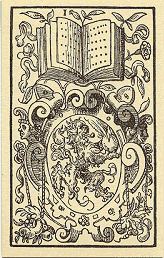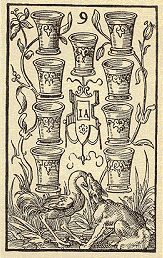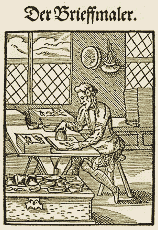In the German city of Nuremberg, in the late 1500s, publisher Leonhardt Heussler had his best
artist produce a set of 52 illustrations in the shape of a full deck of playing cards.
The cards were not printed as sheets, but as pages, bound together into a book.
Besides the illustrations, these pages featured sayings and moral principles
in German and Latin.
It is not clear whether the playing cards, whose details are
very fancy and accurate, were only used as a pretext for describing the sayings,
or were meant to be cut out by the reader, so to obtain a real deck of cards,
more or less in the fashion of some modern picture books for making paper models,
stencils, etc. |
|
1 (ace) and 2 of Cups |
|
1 (ace) and 2 of Ink-pads |
|
Amman's cards belong to the rather numerous group of fancy patterns (mostly tarots)
created during the 16th and 17th centuries, an age in which many artists used
playing card illustrations for testing their skills, with the pretext of adding
spice to a pastime already very popular, yet generally bound to the original schemes.
Had they ever imagined that most playing card players dislike innovations,
probably their efforts would have been turned towards a different source of
inspiration; in fact, none of the fancy editions known ever managed to oust the
local traditional patterns.
|
THE STRUCTURE OF THE DECK
This deck is made of 52 cards, classically divided into four suits of thirteen
cards each, ten of which are pip cards and three are courts.
Although this
composition matches non-German patterns (i.e. Italian, Spanish, French),
we may still include these cards among the German-structured decks, for
many reasons.
In first place, the three courts are typically German: a lower
knave (Unter Knabe), an upper one (Ober Knabe) and a king,
as still found in decks for playing Skat, Jass, etc.
|
|
10 of Cups and Books |

1 (ace) of Books |
In second place, the 10s of each suit do not feature the relevant number of
pips, as the other nine cards do, but show a woman wearing rich clothes (above),
with a small flag in the corner, featuring the roman numeral X.
In reduced scale, this is the same flag found in 10s belonging to the earliest
hunting decks (right), and still present in the German-suited Swiss pattern (see the relevant
gallery).
In third place, two aces of this deck feature a large crest, one of which
vaguely reminiscent of the shape of a heart (ace of Ink-pads, previously shown):
this is a further detail found among the contemporary German-suited Swiss cards.
|

10 of Hounds, from the
Ambraser Hofjagdspiel
(Germany, 15th century) |
|
THE PATTERN
Certainly, what is most striking in looking at Amman's cards for the first time
is the extraordinary beauty of the engravings, which the uncoloured reissue
has fully preserved. The richness of these woodcuts clearly trascends the playing
purpose, as the eye tends to linger on the hundreds of fancy details, almost
distracting the player from each card's actual value.
The four suits are Books, Drinking vessels (or Drinking-cups, straight in shape),
Cups (or Pots, rounded in shape, with decorative humps on the outer part), and Ink-pads
(with a handle, for spreading ink on a printing plate, as shown in one of the
subjects). All the pip cards (except the 10s) have signs variously arranged in the
top part of the card, while in the lower part each subject has a different
illustration, genre scenes whose theme in each of the four suits appears loosely
related.
|

7 of Books |

9 of Cups |
Also the plants or flowers that entwine among the pips, almost forming a
background texture for each subject, are related to the suits: roses for Books,
iris flowers for Drinking vessels, grapes for Cups, and cattail for Ink-pads (probably because
the shape of their flower is somewhat reminiscent of the pad).
In the top part of each pip card, a small western numeral acts as
an index, while the 10s, as previously mentioned, have a small X on a flag.
The courts are indeed very similar to any contemporary German-suited deck.
The lower knave features the suit sign below, on the ground, while the
upper knave has it above, near his head. The king, instead,
is the only mounted personage.
|
Each of the three courts is told by the
aforesaid features, as no name nor index appears in any of them.
Curiously, the king of Drinking-cups is a Turk,
wearing a turban, see below; an identical personage belongs to
the German regional patterns (see this
gallery),
as well as to the German tarot ( Tarock, see Regional Tarots,
page 4).
The special way of representing 10s in early German cards, a feature
that in the country's modern patterns is no longer found,
but it still is in the German-suited Jass deck used in Switzerland,
may be related in some way to the loss of this value in the Spanish
pattern, in which 9s (with nine pips) are followed by the relevant knave.
|
|
Ober and Unter knaves of Ink-pads |
ABOUT THE ARTIST
|
kings of Cups and Drinking-cups |
|
Jost Amman is one of the most prolific illustrators of the 16th century.
Born in Zurich in 1539, he was the son of a teacher of a local renowned college,
but preferred to follow his artistic inclination rather than becoming a scholar
himself. His apprenticeship was carried out partly in Switzerland and, probably,
in France too, as suggested by his early designs. In 1562 he settled in Nuremberg,
where he worked for publisher L.Heussler. His works include portraits,
illustrations for books on various themes, ornamental designs, stained glass
windows, jewelry, and others, although some of his works were inspired by or copied from
previous artists' works. |
Despite his name gradually became well-known, he never
made a fortune, and in his late years he actually lived in poverty. He died in
Nuremberg in 1591, only three years after having finished this deck.
The work he is more often remembered for is the large set of woodcuts used as
illustrations for the so-called Book of Trades (Eygentliche Beschreibung Aller
Staende auff Erden, 1568), which describes in detail over one hundred different
craftsmen and their tools. From the sample shown on the right, the similarity with
the set of cards appears evident.
|

|